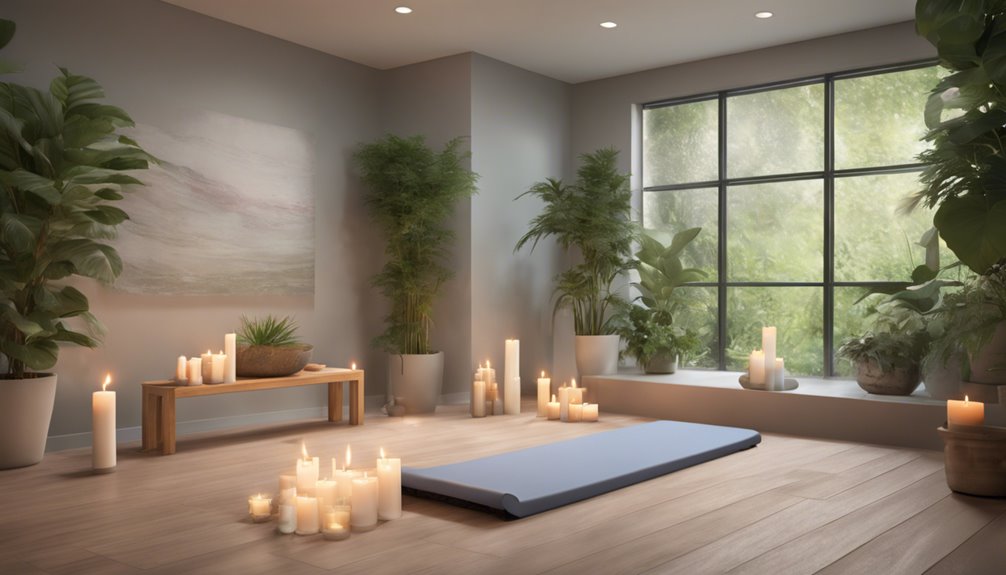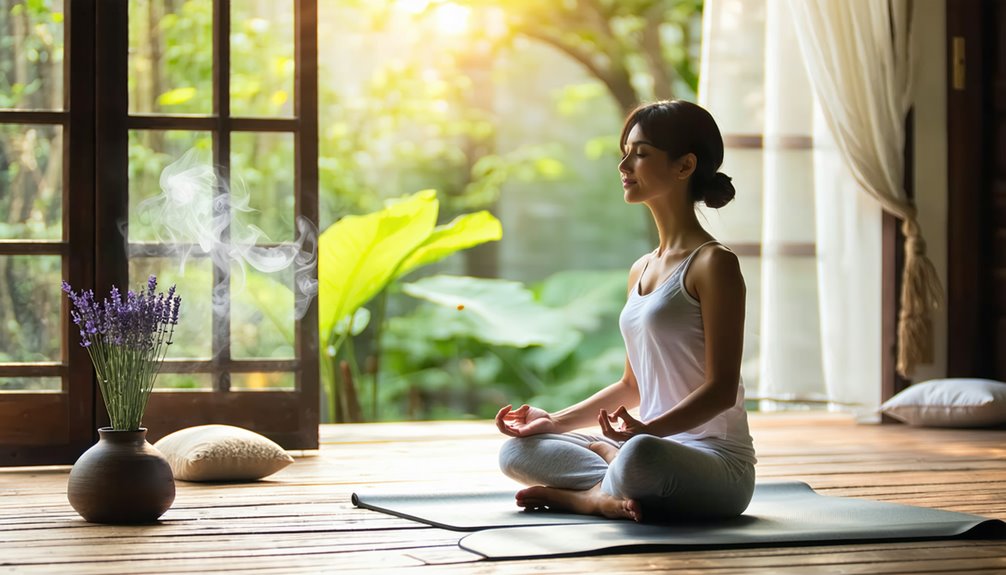To relax your pelvic floor, start with deep breathing techniques. Try inhaling for 4 seconds, holding for 7, and exhaling for 8. Incorporate gentle stretches like Child's Pose or Cat-Cow to release tension. It's also essential to maintain good posture throughout your day. Consider adding mindfulness practices or warm baths to ease muscle tightness. If you experience persistent issues, seeking guidance from a pelvic floor specialist or therapist can be beneficial. Incorporating these practices into your routine may lead to long-term relief and enhance your body's connection. There's much more to explore on this important topic.
Understanding the Pelvic Floor

The pelvic floor is a complex network of muscles and tissues that plays an essential role in your overall health. Understanding pelvic anatomy is vital for recognizing how muscle function impacts daily life. These muscles support your bladder, bowel, and reproductive organs, providing stability and control. When functioning well, they help maintain urinary and bowel continence, as well as sexual health. However, issues can arise if these muscles become too tight or weak, leading to discomfort or dysfunction. By gaining insight into your pelvic floor, you empower yourself to make informed decisions about your body. This knowledge fosters a sense of freedom, allowing you to explore effective ways to enhance your well-being and improve your quality of life.
Importance of Relaxation
Recognizing the significance of a well-functioning pelvic floor naturally leads to the understanding that relaxation is just as important as strengthening these muscles. Many people overlook the role of relaxation in pelvic health, but it's essential for alleviating muscle tension and promoting overall well-being. When your pelvic floor muscles are tense, they can cause discomfort and hinder your body's natural functions. By prioritizing relaxation, you create a balanced approach that allows these muscles to respond effectively to both stress and activity. This balance not only enhances pelvic health but also empowers you to feel more in control of your body. Embracing relaxation techniques can lead to a more liberated, comfortable existence, free from the burdens of tension and discomfort.
Breathing Techniques

How can simple breathing techniques transform your pelvic floor relaxation? By practicing diaphragmatic breathing, you can foster a sense of calm and release tension in your pelvic floor. Start by inhaling deeply through your nose, allowing your abdomen to expand fully. This encourages abdominal relaxation and helps your body switch to a more relaxed state. As you exhale slowly through your mouth, visualize the tension melting away. Repeat this process several times, focusing on the rise and fall of your belly. With consistent practice, these breathing techniques not only enhance your pelvic floor health but also empower you to connect with your body. Embrace the freedom that comes from understanding how breath can facilitate deep relaxation and release.
Gentle Stretching Exercises
Building on the calming effects of breathing techniques, incorporating gentle stretching exercises can further enhance your pelvic floor relaxation. Gentle yoga and stretching routines help release tension, increase flexibility, and promote a sense of well-being. Consider poses like Child's Pose and Cat-Cow, which encourage relaxation in your pelvic area. Focus on slow, mindful movements, allowing your body to open and release without strain. You don't need to push yourself; instead, listen to your body and find a rhythm that feels comfortable. These exercises not only ease physical discomfort but also nurture a deeper connection with your body. By embracing these gentle practices, you're taking a significant step toward achieving a relaxed pelvic floor and overall freedom in your movement.
Mindfulness and Meditation

While you may often focus on physical exercises to relax your pelvic floor, incorporating mindfulness and meditation can greatly enhance your overall sense of calm. By practicing meditation, you create a space for self-awareness and emotional release. Try mindful visualization, where you picture your pelvic floor relaxing with each exhale, allowing tension to melt away. This technique helps connect your mind and body, fostering a deeper understanding of your inner self. Explore various meditation practices, such as guided sessions or breath-focused techniques, to find what resonates with you. As you cultivate this mindfulness, you'll not only notice improvements in your pelvic floor tension but also experience a profound sense of freedom and tranquility in your daily life.
Warm Baths and Heat Therapy
When you seek relief from pelvic floor tension, warm baths and heat therapy can provide soothing comfort and relaxation. Immersing yourself in a warm bath helps to increase blood flow and reduce muscle tension. To enhance this experience, consider adding herbal infusions such as chamomile or lavender, which can further promote relaxation. The aromatherapy benefits from essential oils can transform your bath into a serene sanctuary, easing both physical and emotional stress. You might also use a heating pad on your lower abdomen or back, applying gentle heat to promote muscle relaxation. By incorporating these practices into your self-care routine, you're taking a crucial step toward achieving freedom from discomfort and tension in your pelvic floor.
Professional Help and Therapy

If you're struggling with pelvic floor tension, seeking professional help can make a significant difference. Pelvic floor specialists are trained to provide tailored therapeutic techniques that address your specific needs. Understanding these options can empower you to take control of your health and enhance your overall well-being.
Pelvic Floor Specialists
Seeking help from pelvic floor specialists can be an essential step in addressing issues related to pelvic floor dysfunction. These professionals focus on your pelvic health and can provide tailored guidance. Here are some specialist recommendations to contemplate:
- Physical Therapists: They offer exercises and techniques to strengthen and relax your pelvic floor.
- Urologists: Specialized in urinary function, they can diagnose and treat pelvic floor-related issues.
- Gynecologists: They address pelvic health concerns specific to women, including post-pregnancy recovery.
- Psychologists: Sometimes emotional factors contribute to pelvic dysfunction, and therapists can help address these aspects.
Engaging with these specialists can empower you to reclaim your comfort and freedom, guiding you toward a healthier pelvic floor.
Therapeutic Techniques Overview
Therapeutic techniques play a crucial role in alleviating pelvic floor dysfunction and promoting overall well-being. By focusing on pelvic awareness and tension release, you can discover effective methods to relax and strengthen your pelvic floor. Professional guidance can enhance your journey toward healing.
| Technique | Description |
|---|---|
| Biofeedback | Uses sensors to help you gain pelvic awareness. |
| Manual Therapy | Hands-on techniques that release tension. |
| Pelvic Floor Exercises | Tailored exercises to strengthen and relax muscles. |
| Mindfulness & Meditation | Techniques to promote relaxation and awareness. |
Engaging in these therapies not only supports your physical health but also nurtures your emotional balance. Embrace these therapeutic techniques, and you'll pave the way for lasting freedom and comfort.
Daily Practices for Maintenance
To maintain a relaxed pelvic floor, incorporating daily practices can make a significant difference. You can benefit from mindful breathing techniques, gentle stretching exercises, and posture awareness. These habits not only promote relaxation but also enhance your overall well-being.
Mindful Breathing Techniques
How can mindful breathing techniques enhance your pelvic floor relaxation? By cultivating breath awareness, you can trigger a profound relaxation response in your body. This practice not only calms your mind but also helps release tension in the pelvic region. Here are four mindful breathing techniques to incorporate into your daily routine:
- Diaphragmatic Breathing: Inhale deeply through your nose, allowing your belly to rise, then exhale slowly through your mouth.
- 4-7-8 Breathing: Inhale for 4 seconds, hold for 7, and exhale for 8 seconds to promote relaxation.
- Box Breathing: Inhale for 4, hold for 4, exhale for 4, and hold for another 4 seconds.
- Sighing Breath: Take a deep breath in, then exhale with a sigh, releasing tension.
Integrate these techniques into your life for greater pelvic floor freedom.
Gentle Stretching Exercises
Building on the foundation of mindful breathing techniques, incorporating gentle stretching exercises into your daily routine can further enhance pelvic floor relaxation and overall well-being. Gentle yoga and stretching routines not only promote flexibility but also help release tension throughout your body. Simple movements like cat-cow, child's pose, and seated forward bends can create space in your pelvic area, allowing for deeper relaxation. As you engage in these exercises, focus on your breath, feeling each inhale and exhale as a way to connect with your body. Consistently practicing these gentle stretches can improve circulation and reduce discomfort, empowering you to embrace a more liberated and comfortable existence. Remember, listen to your body and modify movements to suit your individual needs.
Posture Awareness Practices
While gentle stretching exercises lay the groundwork for relaxation, cultivating posture awareness is essential for maintaining pelvic floor health throughout your day. By focusing on posture alignment, you can enhance body awareness and promote a sense of freedom. Here are four daily practices to help you stay mindful:
- Check Your Sitting Position: Confirm your feet are flat, back straight, and shoulders relaxed.
- Stand Tall: Distribute your weight evenly on both feet and engage your core.
- Move with Intention: Be conscious of how you bend, lift, and carry objects.
- Take Breaks: Stand up and stretch every hour to reset your posture.
Incorporating these practices into your routine can greatly improve your pelvic floor health and overall well-being.
Frequently Asked Questions
Can Pelvic Floor Relaxation Improve Sexual Health and Pleasure?
Yes, pelvic floor relaxation can greatly enhance your sexual wellness. When you're able to release pelvic tension, it often leads to improved blood flow and heightened sensitivity, which can heighten pleasure during intimate moments. Additionally, a relaxed pelvic floor helps reduce discomfort, allowing you to engage more fully in sexual experiences. Embracing relaxation techniques not only fosters physical health but also cultivates emotional connection, ultimately enriching your sexual life.
How Does Poor Posture Affect the Pelvic Floor?
Poor posture can greatly impact your pelvic floor. When your posture alignment's off, it can lead to muscle tension in the pelvic area, making it harder for these muscles to relax. This tension can contribute to discomfort and dysfunction. By focusing on maintaining good posture, you can help alleviate this muscle tension, promoting better pelvic floor health and overall well-being. Embracing proper alignment can truly enhance your sense of freedom and comfort in daily activities.
Is There a Connection Between Pelvic Floor Health and Mental Health?
Imagine your mind and body as a finely tuned instrument, where each note affects the harmony. There's a strong connection between pelvic floor health and mental well-being; tension in your pelvic area often mirrors emotional stress. When you experience pelvic tension, it can trap feelings, stifling emotional release. By nurturing both your mental and physical health, you can find freedom, allowing both to flourish and resonate beautifully in harmony with one another.
Can Certain Foods Help Relax the Pelvic Floor Muscles?
Certain foods can indeed play a role in relaxing your pelvic floor muscles. Incorporating herbal remedies like chamomile and ginger can reduce tension, while dietary choices rich in magnesium, such as leafy greens and nuts, may help relax your muscles. Staying hydrated is equally important, as it supports overall muscle function. By being mindful of what you eat, you're not just nourishing your body, but also fostering a sense of freedom and well-being.
How Long Does It Take to See Results From Relaxation Techniques?
You might think results from relaxation techniques are instant, but timing expectations can vary widely. It's crucial to remember that individual factors like your unique body, stress levels, and consistency with practice all play a role. Generally, many people start noticing improvements within a few weeks, while some may take a bit longer. Be patient with yourself; embracing this journey can lead to the freedom and relief you're seeking.




